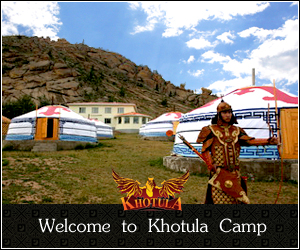Mongolian Historical Figures
Eighth Bogd Khaan (1870-1924)
With the fall of the Manchu dynasty in 1911, the Mongolians proclaimed their independence in December. Fighting against the Chinese, with some aid from the Russians (which was given belatedly), was to continue until August of 1912. Further fighting was to take place in 1913, but this was in present-day Inner Mongolia, and was part of an attempt to create a pan-Mongol state. Indeed, during much of the Bogd Khaan (1911-1921) period and even afterwards, there were attempts to include Inner Mongolia (but not, apparently Buriatia) under the new Ar Mongol regime.
Bogd Khaan braved the might of Chinese rulers to declare independence. While Beijing remained shocked by such impudence from usually meek Mongols, and the bureaucratic machine was slowly eschewing the news, Bogd Khaan liberated the country and announced himself khaan of Mongolia. The warning from Beijing to stop the “mutiny” did not slowed down Bogd Khaan in his far reaching quest for Mongolia’s liberation, including Inner Mongolia as well. In spring of 1913, Mongolian troops defeated the Chinese army on the southern border and advanced to Inner Mongolia, and if were not for the diplomatic demarche of Russian, they would have taken over Beijing. The Russian emissary to Beijing urgently signed with China an agreement, according to which Outer Mongolia was recognized an autonomy and both superpowers consenting not to occupy it. Inner Mongolia, however still remained under the Chinese jurisdiction.
The new state was a theocracy, headed by the Eighth Javzandamba Hutagt (a Tibetan), who was installed on 29 December, 1911, known as the Bogd (Holy) Khaan. Thankful Mongols granted the title of All Elevated Khaan to 42-year-old Tibetan and presented him 99 white mares and 99 white she-camels according to traditions of Chinggis Khaan times. With his ascension to the throne, the (nominal) separation of power into the secular and religious spheres, the dominant political model since the time of Altan Khan, effectively collapsed. After stepping on throne he allowed to set up a two-chamber parliament replacing the National Council consisting of nobles exclusively. Secular nobles were to be found in the new government, but they remained under the control of the Bogd Khaan. He encouraged education and helped to set up a number of non religious schools.
Mongols deeply revered and even loved him. Bogd Khaan came to Mongolia from Tibet at age of five to become the Rebel Monk. His Tibetan name was Luvsanchoijinimadanzinbanchug. Only recently the truth about the life and deeds of Bogdo Khaan, the head of the Lamaism religion and the last Khaan of Mongols emerges. For decades the communist powers badmouthed and distorted his image portraying him as an old debauchee, half blind syphilitic and the oppressor of people. But in reality he was the key figure behind the declaration of independence of Mongolia after 200 years of Chinese rule. For his quest of the country’s independence he was named the Rebellious Priest. It was him who ordered in 1911 to arrest the Peking appointed governor and defeated the Chinese garrison taking Manchu rulers by surprise.
He died on April 1924 and was buried with honors inside the Gandan monastery. Few years later the monastery was turned into a barrack for Russian military and his remains disappeared without trace. The Summer Palace of Bogdo Khaan is now a museum.
Mandukhai the Wise Queen
Manduhai Tsetsen Hatan or Manduhai the Wise Queens role in Mongolian history is ensuring Batmunkh Dayan Khan’s success. Notes about her and her background Grand Khan Manduul, Chinggis Khan’s twenty-seventh successor, died in 1467 as the result of a war against his great-nephew and their Bold Jonon [regent], and the latter in his turn was assassinated before he could be proclaimed khan (1470).
Of the once so numerous Khubilaid family [descendants of Chinggis through Khubilai Khan] there Dayan, the son of Bold Jonon, who was ‘deserted by everyone, even his mother, who had remarried.’ Manduul???s young widow, Manduhai, took the child under her protection and proclaimed him khan. She herself then assumed command of the loyal Mongols and inflicted a defeat on the Oirad. In 1481, she married young Dayan. In 1491 -92, this heroic woman, whose exploits recall those of Ouleun-ekhe, Chinggis Khaan’s mother, ‘is again depicted at the head of an army which repulsed the Oirad.’ It is to her that tradition gives credit for having overthrown Oirad supremacy and restored hegemony to the eastern Mongols (1970: 509).
Little else is known about Manduhai, although Haworth mentions she had seven sons, including two sets of twins (1876: 372-3). She is also mentioned in the Mongolian chronicle, Erdeniin Tovch written by Sagan Setsen in 1662 (Krueger 1967). While not dismissing her entirely, the Russian scholar Pokotilov refers to her marriage to the young Batmunkh as a “poetical legend” (1976: 79).
Whatever the true facts surrounding her, what is central to our understanding of Manduhai and the role she plays in socialist era history books are two basic points. First, by marrying Batmunkh, she managed to keep the Golden Lineage (as Chinggis’s descendants are known) in a position of actual, as well as nominal, power. Second, in her campaigns against the Oirad, she set the stage for Batmunkh’s attempt at re-uniting the Mongols. (And thus, under socialism was credited with halting ‘feudal disintegration’. Batmunkh Dayan Khaan (1470-1 543) continued the campaigns begun by Manduhai, and ruled briefly as Khaan over the united Mongol tribe.
Zanabazar
Zanabazar was the 16th Incarnation of Javzandamba. The name Zanabazar, a combination of the word zana, which is derived from a Sanskrit word meaning “knowledge” or “wisdom”, and the word bazar, meaning “thunderbolt”. Thus in English his name might be rendered “thunderbolt of wisdom”.
The boy began speaking at the age of three. According to legend his first words were the Buddhist invocation Ala-la-ma duy-sun-san-jiy-di choy-ji-kor-lo-bardu-la-na-med. Soon he was reading and reciting prayers for most of the day, without any instruction or coaxing. When he wasn’t praying or making offers he spent his time building small replicas of temples, fashioning small statues of Buddha, and drawing portraits of great lamas. Although by tradition the son of a khan was supposed to be surrounded by playmates from other noble families the little boy chose to ignore them completely and instead focused all his energies to his devotional practices.
Before the end of his third year, in early 1638, his father, by then convinced that the boy was destined for a religious life, arranged for a lama named Jambaling to give him his first monastic vows. With these came a new monastic name, (nanavajra) Yesun Zuil, where Avtai met the mendicant who was thought, at least by some, to be the Third Lama Dalai in one form or another, and where Zanabazar was born, is located in what is now Uvurkhangai Airnag, about twenty-seven miles south of a village of the same name. The geographical center of the current country of Mongolia is about thirty miles north of here, near the town of Burd.
At Yesun Zuil-Zanabazar’s birthplace, and not the village-were nine springs which never froze over in winter (according to locals these springs have since gone dry), and it is these which give the place its name yesun = nine; zuil = types, or kinds). Eventually a temple was built on the site where legend maintains that Avtai built the ovoo to commemorate his meeting with mendicant-lama he believed to be the Dalai Lama. Because it was surrounded by eight large stupas it became known as the Eight Stupas Temple. It was destroyed in the 1930s by the communists, who were particularly keen on erasing any memories of Zanabazar, the first of the Bogd Gegeens, the figureheads of Buddhism in Mongolia.
Local people and pilgrims later heaped up rubble from the ruins into a large ovoo which stood as a replacement for Avtai’s original monument and the Eight Stupas Temple. It was destroyed during the anti-religious campaigns of the 1930s. In 1997 the ruined walls of some of the buildings of this monastery still stood, but by 2003 they had been torn down for building materials. In the early 1990s a small temple and a white stupa were constructed next to the ruins. In 1995 a painting and a near-lite-sized statue of Zanabazar were placed in the otherwise sparsely appointed temple to commemorate the 380th anniversary of ‘Zanabazar’s birth.
Modun Shanyu
The first powerful state of nomads appeared in central Asia under the name of Hunnu. The Khan of the Hunnu was called the shanyu. In 209 B.C., 12 years after the Chinese created their defensive state of the Qin, prince Modun killed his father Tumen shanyu and usurped the throne. According to legend, Modun persistently demanded his soldiers to shoot where he shot. Once, when he sent an arrow towards his favorite horse, some soldiers did not follow suit, and lost their heads for disobeying order. Next time he shot at his wife. Several men were very shocked by this strange act, thus forgot to obey the order. They were beheaded as well. At last the prince aimed at his father, so many arrows were released that the body of the shanyu could not accommodate them all. This talented military leader apparently did kill his father solely for the sake of becoming the Shanyu.
Modun’s ultimate goal was to build a state powerful enough to overcome the Great Wall and assail Qin China. This required a huge organizational transformation, which the father seems to have been unwilling or unable to implement. His population was sub-divided into myangat, zuut and aravt units of 1000, 100 and 10, respectively. The leader of a unit was accountable-with his own head to the leader of the immediate superior unit while every rank-and-file soldier was answerable else in his own unit. This helped forge an iron-like military discipline.
The state of the Hunnu reached the peak of its power under Modun, whose decrees were omnipotent across territory stretching from the Lioa River in the east to Turkistan in the west, and from Lake Baikal in the North to the Great Wall of China in the South. Eventually, utterly hasted by the endless raids, China`s Han dynasty came to pay him tributes on be half of its fourteen million subject. In198 B.C. the dynasty reached a peace agreement with the nomads, and offered them, rather heartlessly, a gift of a Han princess.












